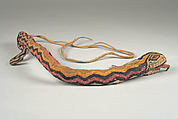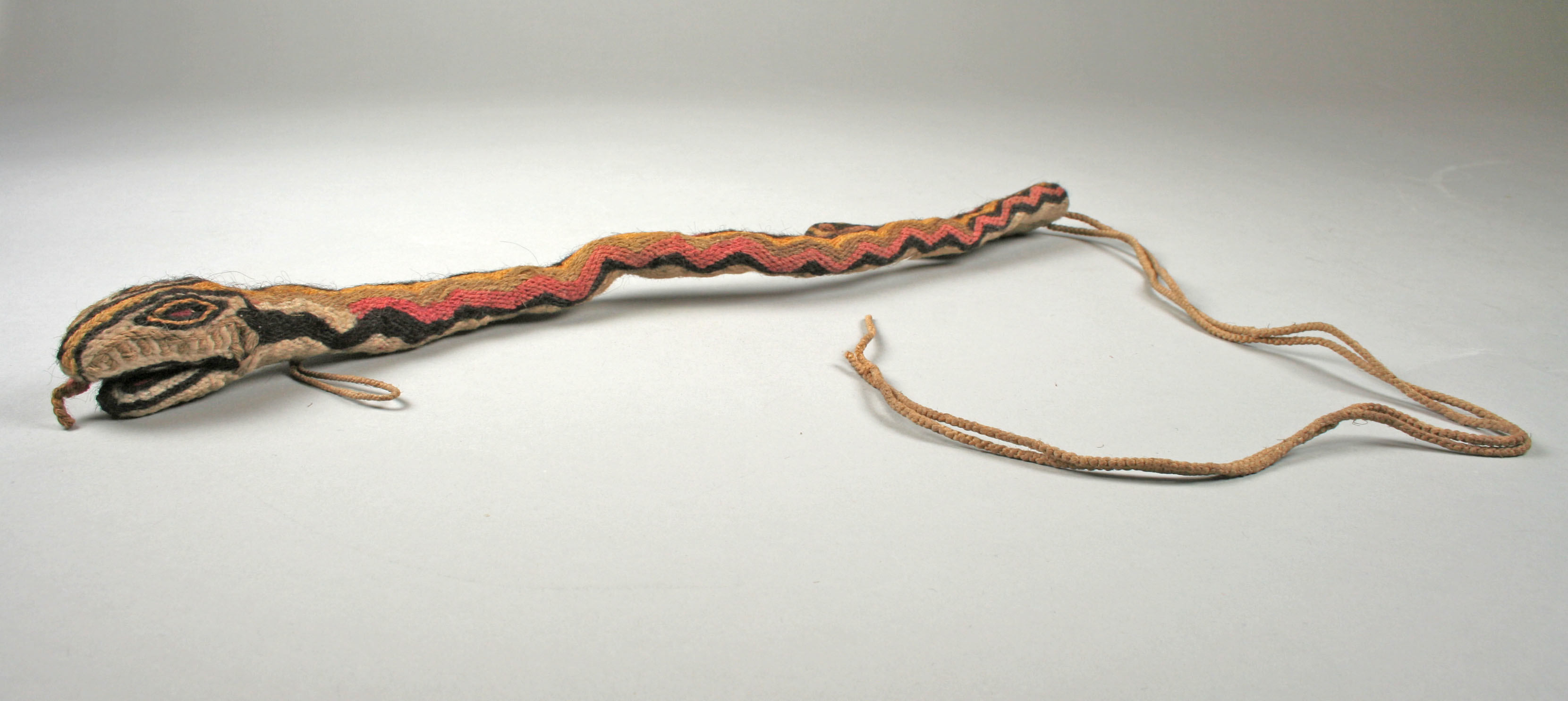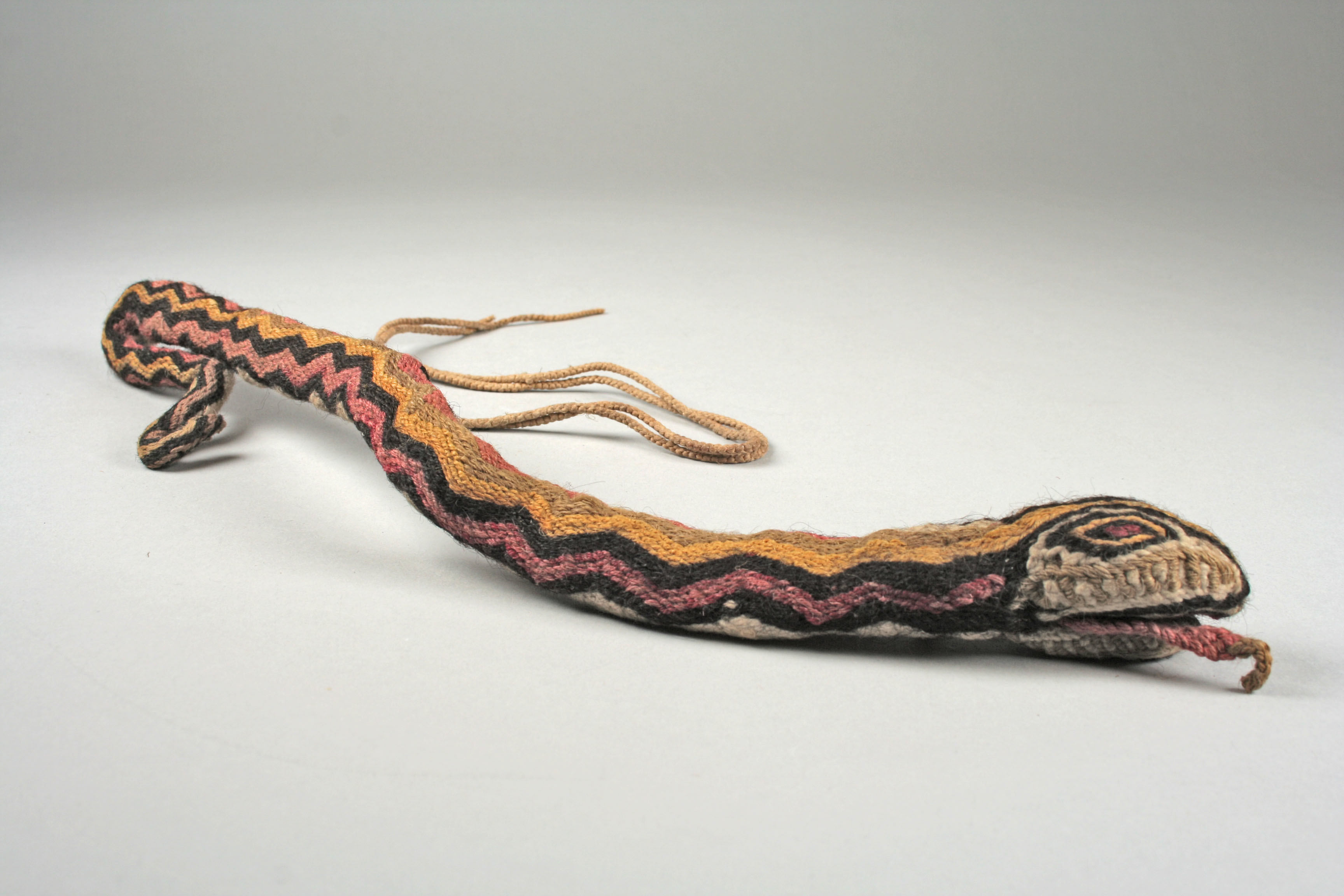Serpent ornament
Not on view
This exquisite three-dimensional textile representation of a serpent is from the South Coast of Peru and was likely fabricated in the 16th century. With a sinuous body, elliptical-concentric eyes, open red mouth, and protruding tongue, the snake threatens us, while at the same time its colorful body, with its lively red, yellow, black, and light brown zigzag lines, engages us. A double-braided rope is tied to the distal end, while a braided ring is inserted on the ventral side near the head, and would be used to secure the effigy snake. Although the function of this serpent is a matter of discussion, early colonial chronicles shed light on its likely use and meaning. For example, the anthropologists Tom Zuidema (1967) and Anne-Marie Hocquenghem (1997, 2008) have written essays about the symbolism of the serpent in the Inca Empire. In a ritual combat known as ayllar, snakes made of wool were used as projectiles. This effigy snake may have been worn around the neck—a powerful personal adornment of the paramount Inca and his allies—until it was needed as a weapon. The wearer would then grab the cord, swing the snake, and hurl it in the direction of the opponent. The heavy head would propel the figure forward. The simultaneous release of many would produce a scenario of “flying snakes” thrown at enemies.
Textile artisans of ancient Peru, acknowledged as among the finest weavers in the world, mastered numerous techniques to produce various types of cloth. Less familiar are non-weaving techniques, some of which were used to produce sculptural textiles such as the present example. During the Late Horizon period (A.D. 1470–1532), textile specialists on the South Coast of Peru excelled not only in producing marvelous weavings, but also in the production of slings, sashes, and decorative accessories elaborated using a non-weaving technique described as vertical stem stitch (Emery 1966:55). This technique was probably introduced by the Incas, at the time of their arrival on the South Coast. Objects such as the present example would be produced by shaping a cotton or wool core, in this case a snake, which was then wrapped in structural cords. Following this, the surface design was created using colorful threads to achieve the serpent’s zigzag pattern. Additional supplementary embroidery was used to accentuate certain features of the face. Other examples of serpents made by this method also have strings indicating that they, too, may have been thrown (Moraga, 2016).
The style of this serpent suggests that it was created on the South Coast of Peru at a time when the kingdom of Chincha was under Inca rule. The Chincha kingdom maintained a certain degree of autonomy, however, and Inca rule in this territory was promoted through the construction of an administrative center and a temple dedicated to the sun (Netherly, 1998). As that temple blended imperial and local features, so too this serpent blends local stylistic elements with aspects of Inca religious practice, specifically the veneration of the serpent (amaru or machacuay in the Quechua language). Before the arrival of the Inca, Chincha iconography did not include depictions of serpents, but it did include geometric motifs such as zigzags, as well as birds and fish. Thus, local Chincha elements were adopted into the new cult of serpents.
In Andean cosmology, the snake represents one of the animals with the greatest symbolic significance, feared for its aggressiveness and fierceness, but also recognized for its association with fertility, rain, and protective powers. From at least the third millennium B.C., these qualities were recognized by inhabitants of the Central Andes. The earliest representation of a snake appears in a textile from the Preceramic period site of Huaca Prieta (ca. 2,500 B.C). In this early fabric, cotton threads woven in twining-transposed-warp technique (Bird 1985:160) represent a snake in the entrails of a condor in flight. In later periods, serpents were depicted using a variety of other textile techniques including tapestry, brocade, double cloth, embroidery, and complementary warp/complementary weft methods.
Early colonial chronicles describe the Inca snake cult in detail and the objects used in such rituals. In addition to the ayllar ritual combat mentioned above, the taqui yanayra dance features men and women holding an exceptionally long rope that metaphorically represents a serpent. Known as moro urco, the rope was made of four colors: black, red, white, and cream. The dance was performed in Cuzco’s central plaza, preceded by the Inca himself. At the end of the dance, the moro urco rope was deposited in the Coricancha, the “golden enclosure” that served as the Temple of the Sun, and the resting place of venerated ancestors (Hocquenghem 2008). The objective of this ritual was to transmit the life force emanating from the ancestors (camac) to the people (camasca) via serpents. Through these historical sources, and the objects themselves, we are able to gain a clearer sense of Inca religious ideology, and the powerful ritual works—such as this effigy snake—that gave ideas form.
Arabel Fernández López, Andrew W. Mellon Foundation Conservation Fellow, 2020
References
Bird, Junius B., John Hyslop, and Milica Dimitrijevic Skinner. “The Preceramic Excavations at the Huaca Prieta, Chicama Valley, Peru.” Anthropological Papers of The American Museum of Natural History. New York. Vol. 61 (1985), Part 1.
Emery, Irene. The Primary Structures of Fabrics. An Illustrated Classification. Washington, D.C.: The Textile Museum, 1966.
Hocquenghem, Anne Marie. “Los colmillos y las serpientes. La autoridad absoluta de los ancestros.” In Cosmos, hombre y sacralidad. Cuadernos de Antropología 2, 2nd ed., Marco V. Rueda and Segundo E. Moreno, eds., pp. 257-266. Quito: Abya Yala, 1997.
Hocquenghem, Anne Marie. “Sacrifices and Ceremonial Calendars in Societies of the Central Andes. A Reconsideration.” In The Art and Archaeology of the Moche. An Andean Society of the Peruvian North Coast, edited by Steve Bourget and Kimberly L. Jones, pp. 23–42. Austin: University of Texas Press, 2008.
Moraga, Vanessa Drake. Shamans, Supernaturals and Animal Spirits. Mythic Figures from the Ancient Andes. A Visual Encyclopedia. Vol. II. Larkspur, CA: Ololo Press, 2016.
Netherly, Patricia. “El reino de Chimor y el Tawantinsuyu.” In La frontera del estado Inca. Tom D. Dillehay and Patricia Netherly, eds., pp. 85–105. Fundación Alexander von Humboldt. Quito: Abya Yala, 1998.
Zuidema, Tom. “El juego de los ayllus y el amaru.” Journal de la Société des Américanistes vol. 56 (1967), No. 1, pp. 41–51.
Due to rights restrictions, this image cannot be enlarged, viewed at full screen, or downloaded.
This artwork is meant to be viewed from right to left. Scroll left to view more.





